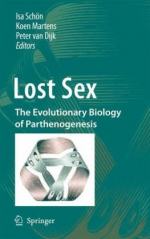|
This section contains 547 words (approx. 2 pages at 300 words per page) |

|
In most living things, fertilization occurs when the gametes of two compatible creatures are brought together. In mammals, these gametes are the (female) egg and the (male) sperm. When they meet, the egg and sperm will fuse into one body, allowing genetic information from the two parents to combine. As the offspring grows, it displays genetic traits similar to each of its parents, as well as traits uniquely its own. In this way, genetic diversity is preserved. However, there exists in nature a phenomenon known as parthenogenesis ("virgin birth"), in which an egg cell can develop into an offspring without being activated by a sperm. In such cases, the offspring, as well as its siblings, would be genetically identical to the mother. Parthenogenetic offspring can be male or female, and haploid (chromosomally normal) or diploid (chromosomally doubled), depending upon the species.
Natural parthenogenesis was discovered by the Swiss...
|
This section contains 547 words (approx. 2 pages at 300 words per page) |

|


